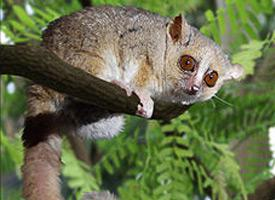
Súlyok és méretek
| Hossz | 63-tól 85-ig cm |
|---|---|
| Súly | 1 kg |
Állatleírás
The Eastern woolly lemur (Avahi laniger), also known as the Eastern Avahi, is a fascinating and distinctive species of primate native to the dense, humid rainforests of Madagascar. This nocturnal creature is a member of the family Indriidae, which it shares with the larger and more vocal indris and sifakas. Characterized by its dense, woolly fur, the Eastern woolly lemur is uniquely adapted to life in the cooler climate of the island's eastern forests.Adult Eastern woolly lemurs typically weigh between 1 and 1.3 kg, with a body length ranging from 27 to 29 cm and a tail that is slightly longer, measuring around 33 to 37 cm. Their fur is primarily grey or reddish-brown, providing excellent camouflage amidst the foliage of their arboreal habitat. One of the most striking features of the Eastern woolly lemur is its large, expressive eyes, which are a deep, reflective orange or yellow. These eyes are not just for show; they are crucial for the lemur's nocturnal lifestyle, allowing it to see in the dim light of the forest at night.
The diet of the Eastern woolly lemur is predominantly folivorous, meaning it feeds almost exclusively on leaves, although it may occasionally consume fruit, flowers, and bark. This diet is relatively low in nutrients, which is why the lemur has a large, complex cecum – part of the large intestine – where symbiotic bacteria help break down cellulose in the leaves, allowing the lemur to extract the maximum amount of nutrients. This specialized diet and digestive system mean the Eastern woolly lemur spends a significant amount of time feeding to meet its energy requirements.
Socially, Eastern woolly lemurs are known to form monogamous pairs or small family groups, typically consisting of the mated pair and their offspring. These groups maintain and defend territories, which they mark using scent glands. Vocal communication among Eastern woolly lemurs is relatively limited compared to other lemur species, likely due to their nocturnal nature and the dense forest habitat. Instead, they rely more on scent marking and body language for communication within the group and to ward off rivals.
Reproduction in Eastern woolly lemurs follows a seasonal pattern, with mating occurring during the dry season and births during the early rainy season. Females usually give birth to a single offspring, which they carry on their belly for the first few weeks. As the infant grows, it transitions to riding on the mother's back. Juveniles are cared for extensively by both parents and may remain with the family group until they reach sexual maturity and leave to form their own groups.
The Eastern woolly lemur is considered to be endangered, primarily due to habitat destruction caused by slash-and-burn agriculture, logging, and mining. The fragmentation of their forest habitat not only reduces the area available for these lemurs to live and feed but also isolates populations, making it difficult for individuals to find mates and leading to a decrease in genetic diversity. Conservation efforts are underway to protect the remaining populations of Eastern woolly lemurs, including habitat preservation, reforestation projects, and education programs aimed at reducing human impact on these remarkable creatures and their environment.
In summary, the Eastern woolly lemur is a unique and integral part of Madagascar's rich biodiversity. With its specialized diet, monogamous social structure, and distinctive appearance, it captures the fascination of scientists and conservationists alike. However, like many of Madagascar's endemic species, it faces significant threats from human activity, and concerted efforts are required to ensure its survival for future generations to marvel at and study.
Hasonló állatok
Új állatfotók
Top 10 állat
- Diana monkey (Cercopithecus diana)
- Dolphin gull (Leucophaeus scoresbii)
- Moustached guenon (Cercopithecus cephus)
- Galápagos tortoise (Geochelone nigra complex)
- Stone loach (Barbatula barbatula)
- Japanese spider crab (Macrocheira kaempferi)
- Colossal squid (Mesonychoteuthis hamiltoni)
- Common house mosquito (Culex pipiens)
- Common reed warbler (Acrocephalus scirpaceus)
- Sea urchins (Echinoidea)
